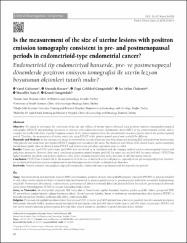Is the measurement of the size of uterine lesions with positron emission tomography consistent in pre- and postmenopausal periods in endometrioid-type endometrial cancer?

View/
Date
2018Author
Gülseren, VarolKocaer, Mustafa
Güngördük, Özgü Çelikkol
Özdemir, İsa Aykut
Sancı, Muzaffer
Güngördük, Kemal
Metadata
Show full item recordAbstract
Objective: We aimed to investigate the correlation of the size and volume of uterine tumors obtained using positron emission tomography/computed tomography (PET/CT) and pathology specimens in patients with endometrioid-type endometrial cancer (EEC) in the premenopausal period, and to compare the results with those of postmenopausal women. In the premenopausal period, the endometrium uses more glucose than in the postmenopausal period. Therefore, the measurement of uterine tumor size using PET/CT in the premenopausal period may normally be different. Materials and Methods: In this retrospective study, we reviewed the records of patients who were diagnosed as having EEC and underwent hysterectomy. Only patients who underwent preoperative PET/CT imaging were included in the study. The thickness and volume of the uterine lesion, and its maximum standardized uptake value as obtained using PET/CT and hysterectomy pathology specimens were recorded. Results: Tumor size (p= 0.051) and volume (p= 0.404) were not found to be correlated with the imaging method used in premenopausal women and pathologic specimens. However, there was a correlation in postmenopausal women (p< 0.001 for tumor size and p< 0.001 for tumor volume). PET/CT has higher sensitivity, specificity, and positive predictive value in the postmenopausal period in the detection of > 20 mm uterine tumors. Conclusion: PET/CT has a limited role in the measurement of the size of uterine lesions in all patients, especially in the premenopausal period; therefore, we recommend that frozen-section examinations be used intraoperatively to decide on lymph node dissection.
Source
Turkish Journal of Obstetrics and GynecologyVolume
15Issue
1URI
https://doi.org/10.4274/tjod.64188https://app.trdizin.gov.tr//makale/TXpBM01qZ3hNUT09
https://hdl.handle.net/20.500.12809/1526

















